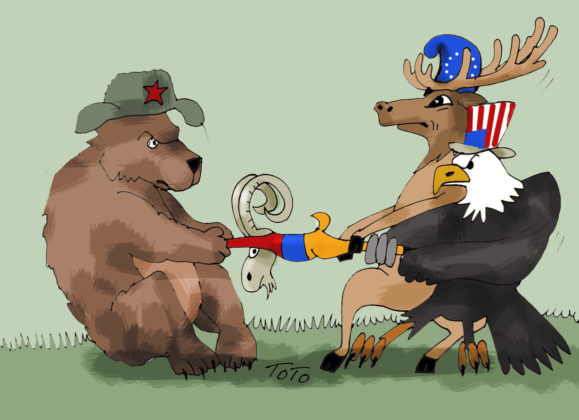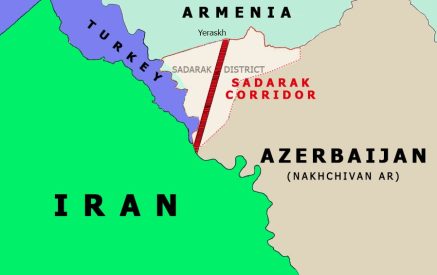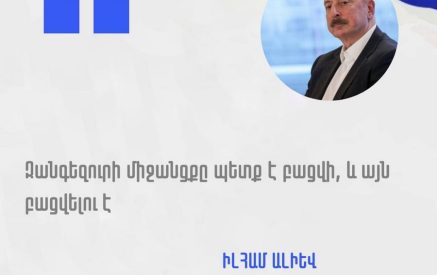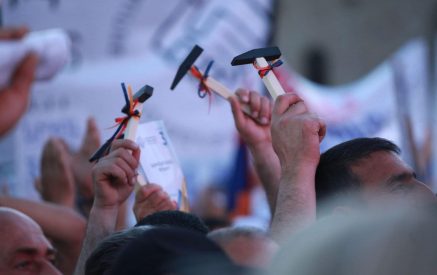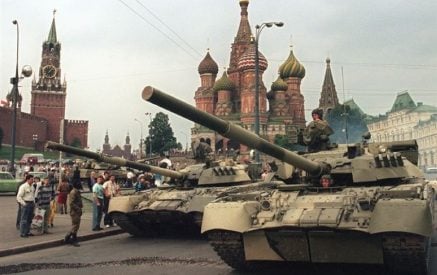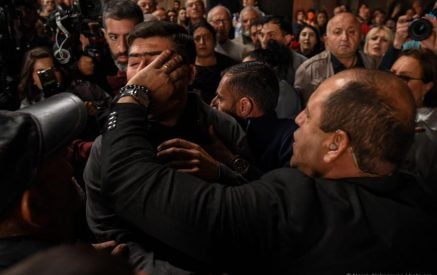by Edmond Y. Azadian
Armenia is currently in the throes of a dilemma, pondering who will sign the fateful peace treaty with Azerbaijan, which may amputate Armenia’s territory, in exchange for the elusive hope that security may return to its borders. Azerbaijan’s policy, with regards to Armenia, is fueled by the hatred shown recently to the world through videos of the barbaric torture, murder and dismemberment of an Armenian woman soldier and the group execution of Armenian POWs, recently released in a grisly clip, which warrants a legal response as war crimes.
The situation is very fluid in the Caucasus political sphere, favoring the Baku-Ankara tandem, at the moment. Turkey and Azerbaijan are not seeking stability and peace in the region; rather, they are banking on the balance of power which fluctuates daily, to extract maximal concessions from Armenia. Turkey, in particular, has long tentacles reaching the region. One goal is to coerce Armenia to provide an extraterritorial land passage to serve the former’s pan-Turanian project, while a greater one is to eliminate Armenia from the face of the globe altogether, and thus render the case of the Genocide defenseless.
Read also
The issue of the Armenian Genocide is a monumental legal hurdle on Turkey’s path to achieve its global ambitions, which include membership in the European Union and on the United Nations Security Council. As long as there is an Armenian state which can espouse legally the cause of the Genocide, Turkey will be haunted by that hurdle. There is no clearer example than the case of the Assyrians to show what a big difference a state backing claims makes in the global scene. Wrongfully, Prime Minister Nikol Pashinyan has relegated the matter to the diaspora, in the hope of appeasing Turkey. However, the Genocide is the legal burden of the Armenian state.
At this point, Armenia is caught in the turbulence of the Caucasus, which Russia considers its zone of influence, while the West is trying to dislodge the latter, using the conflicting interests in the region to its advantage.
For a long time, Moscow took for granted that it had Armenia in its fold, no matter what, particularly using the historical fears engendered by Turkey. Russia is so engrained in Armenia’s political, social and military life that it would be almost impossible to extricate the country from its embrace; and there would be no reason to part from Moscow’s sphere, were it not for Russia’s abandonment of its treaty obligations vis-à-vis Azerbaijan’s aggression. Perhaps Russia expected some sympathy from Armenia about its own current predicament, in exchange for its historic support of Armenia, but the latter no longer can afford that sympathy, when it has been facing an existential threat without receiving any help.
Russian statesmen, from President Vladimir Putin down to Foreign Minister Sergey Lavrov and Russian Ambassador to Armenia Sergey Kopyrkin, continue to tout the smokescreen of Russia’s role in halting the 44-Day War or the recent Azerbaijani aggression on September 13. Such talk may satisfy their desire for political cover but does not help the 4,800 victims of the 2022 war or the 207 casualties of the recent flareup.
The Collective Security Treaty Organization (CSTO) and the various Armenian-Russian treaty obligations required the prevention of such aggression rather than the expectation that Armenia be grateful for the prevention of further wholesale massacre.
When the Velvet Revolution took place in 2018, Russian commentators and their Armenian cohorts in Yerevan tried to present the political movement as another color revolution aimed against Russian influence. Yet, as time passed, leaders in Yerevan were very cautious not to tread on the paws of the “bear” in the north.
As political events unfolded, Russia’s delinquency in its commitments encouraged Armenia to voice its resentments and seek alternative source of political support and arms.
In the aftermath of the September 13 attack, three members of the United Nations Security Council — France, the US and the UK — clearly pointed to Azerbaijan as the aggressor and demanded the removal of Azerbaijani forces from the sovereign territory of Armenia, while Russia continued dilly-dallying and covering up the aggression under the guise of a “border dispute,” advocating that there is no clear demarcation of borders.
Armenia appealed to the CSTO for military support, triggering Article 4 of the organization, which says that attack on the territory of one member is an attack on all members. Instead of taking action, however, the organization sent CSTO Secretary General Stanislav Zas to Armenia with a delegation.
The Chief of Staff of CSTO Anatoly Sidorov, after arriving in Yerevan, warned: “Let’s not get ahead of ourselves. On September 13, the heads of our states unanimously declared that political and diplomatic methods should solve the problems that the exist between Armenia and Azerbaijan.”
That kind of statement sounds like a joke when blood is flowing.
In the first place, Pashinyan refused to meet with the Zas delegation, to express his displeasure, and announced that in recent contacts with a number of colleagues from CSTO, he stated that public sentiments in Armenia towards the organization are developing and changing rapidly. Pashinyan continued: “During the conversation, it was said that there are fears that Armenia will leave the CSTO. I formulated the opposite, that there are fears the CSTO will leave Armenia.”
Prior to that statement, Pashinyan had called for international monitoring forces on the border, setting fear in the hearts of the Kremlin policymakers, that soil would be taken from under Russian feet in the Caucasus. Maria Zakharova, the Foreign Ministry spokesperson, reacted furiously, saying it is a fantasy to invite international forces.
Following Zakharova’s outburst, Foreign Minister Lavrov, in a sterner voice, heralded that “we have to await the results of Zas’ visit.” That added insult to injury, as if the unburied bodies of Armenian soldiers — paraded by Azerbaijan — were not enough of a statement about the situation.
There is an ambivalence in Armenia about the prospect of leaving the CSTO. Armenia’s Deputy Foreign Minister Vahe Gevorgyan states, “Armenia is expecting clear actions from the CSTO on the restoration of territorial integrity of Amenia as a member state of CSTO, as well as the prevention of new escalations.” In reply, the Vice President of the Republican Party’s I Have Honor faction Armen Ashotyan stated, “Yes, the CSTO is not perfect and not the best security system. But unfortunately, Armenia has nothing else. Leaving the CSTO can only aggravate the problems and create a security vacuum.”
An almost identical statement was issued by political scientist Alexander Iskandaryan. Western-leaning political groups are pushing for leaving the CSTO in the hopes that the West will fill in the political vacuum. That fear is real also in Moscow.
If nothing else, Armenia’s initiative has already sensitized the Kremlin’s policy makers to take the perceived danger as real and they have reacted accordingly. Thus, until recently, Moscow kept complete silence every time Turkish leader Recep Tayyip Erdogan, Foreign Minister Mevlut Çavusoglu or Azerbaijan’s President Ilham Aliyev insisted on the Zangezur Corridor and they sounded as if that was a done deal. But recently, the Russian member of the Trilateral Commission of Deputy Prime Minister Alexey Overchuk stated firmly that the transportation routes to be opened, including the Zangezur Corridor, will remain under Armenia’s sovereign territory.
Thus, at least one threat is eliminated temporarily, as Aliyev was insisting on a peace treaty where Armenia would sign away Karabakh’s existence and its rights over the proposed corridor.
As the fateful moment of the peace treaty approaches, we will find out what Moscow’s stand would be on the issue of Karabakh.




















































